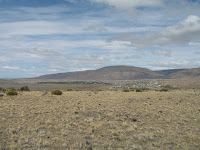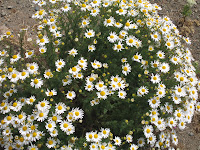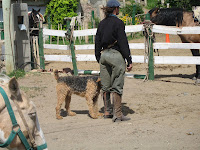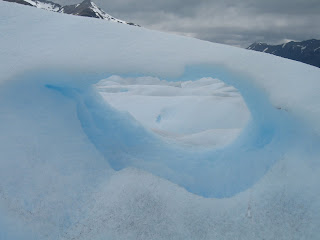Friday, January 08, 2010
It's a small world
----
So first off, let me say that I'm pissed at Aerolineas Argentina. I got to the airport this morning to fly from El Calafate to BA, and they had a) overbooked the flight to start with and b) changed equipment to a smaller plane. Consequently, Strategerist did not make it on her flight. The good news is that there is free wifi and a place to vent. I tried every trick in the book to get on the flight and nothing worked. I asked for compensation, they refused. I stood at the counter and refused to move. In the end, I got a voucher for lunch. Small victories.
So I'm sitting in the airport lounge, and I find the ONE outlet to plug my ghetto ancient computer in to. And I'm happily logging on and all that and suddenly I have the urge for a cafe con leche. So I turn to these two guys in the corner of the cafe playing scrabble and ask them to watch my computer. I notice that they have a lot of Z's on the board, so I ask them where they are from. Poland, they respond. One from Warsaw, one from Krakow. And I get so freaking excited. I tell them that I have visited Poland, but that's not why I'm excited. I'm excited, because there was some measure of divine fate earlier in the day...
I was packing my bags and trying to organize my stuff. I was pulled my ipod out of a plastic bag, and it kind of got stuck. So I pull harder and I see something attached/hanging off of the earbud. I was pissed that I had broken it or something like that (wouldn't be the first time I've crushed those earbuds). Anyhow, it was my Solidarity pin (Solidarnoss) that I picked up in Poland in June 1989. It is my absolute favorite souvenir in the world. I've written essays on this pin. And here it was, in some random bag in Argentina. And I was pissed at myself because it should not have come and I'm not sure how it got to Argentina or mixed in with my stuff. So I put it away in my laptop bag, figuring this was the safest place for it.
So when I meet these two Poles and we start talking about Poland, I suddenly remember the pin; I dart to my bag, pull it out, and show it to them. They were more than impressed and asked me how I got that. I explained that my family took a vacation to Poland, Czechoslovakia, Hungary, and Romania in the summer of 89. They looked at me and said, 1989? Like they needed reassurance that I wasn't a lunatic. I insisted it was 89 and that's how I got the pin. Then they wanted to know what kind of family takes their vacation in the Soviet Bloc? Answer: the kind that produces a child who thinks Patagonia, Central Asia, and other remote places are fun!
Thursday, January 07, 2010
Fingerpainting
I went first thing this morning to see the Walichu caves just outside of El Calafate. The caves have 4,000 year old fingerpaintings. You know, cave drawings/paintings. Some hand prints and some other designs.

I think in this one you can more clearly see the "negative hands" with the white print with red outline. My guide called the upside down ones negative, and I certainly don't know that's not what they're called. These ones are made by putting your hand on the rock (and they chose good rock to do it on as there were many types in these caves) and then using guanaco blood to paint all around it. Guanacos are related to llamas and camels and are essentially wild llamas. Although I have been on the lookout for them, I haven't seen any yet. And I doubt I'm going to find any in BA.

Here are some fingerpaintings of people. They seemed to be of the stick-figure school of fingerpaint. The really tall one on the left is the shaman.

 Some paintings of caves maybe? And then lots of dots in a circle.
Some paintings of caves maybe? And then lots of dots in a circle.
After visiting the caves, I went to check out the regional museum in Calafate. I had been told it was small and quite good. Both accurate descriptions. It had an exhibit on all of the extinct big mammals and mega-animals (that is not what they were called, but that's what I'm calling them). They had some cool bones and fossils on display. Like a mini natural history museum.

I WALKED ON WATER!
Wednesday was a great day. I signed up for Helios y Aventura's "Big Ice" trek. It's about a 7-8 day of hiking, half on Perito Moreno Glacier, and half on terra firma. I found the later to be more difficult than strapping on some crampons and climbing on ice, although that did present some challenges as well. We started out the day in Calafate and drove the 90 minutes to the glacier. We walked along much of the same path I walked on Monday, taking a look at the northern wall of the glacier. I'm glad I spent a full day there though, because that enabled me to watch the calving, and really enjoy it. This was just a quick walk through the balconies, with a short stop or two for photographs. I did, however, have the chance to see three condors (3 days of the condor?).

After visiting the glacier and walking along the path, we headed for the dock to catch a boat along the eastern/southern face of the glacier, across a lake, to get to the land so we could hike up alongside. There were some crazy pieces of ice in the water.

 We climbed the side of the glacier, probably a 300 to 400m gain in elevation, in a bit under 90 minutes. Nothing too crazy, but there were some very steep parts. We stopped along the say to pick up our crampons and then to get into our harnesses. We were not attached to one another, but it was so that if we fell into some crevasse, we could be lifted out easily (that is if we didn't drown or freeze first, I was a bit pessimistic about the utility of these harnesses, but I wasn't about to go without one).
We climbed the side of the glacier, probably a 300 to 400m gain in elevation, in a bit under 90 minutes. Nothing too crazy, but there were some very steep parts. We stopped along the say to pick up our crampons and then to get into our harnesses. We were not attached to one another, but it was so that if we fell into some crevasse, we could be lifted out easily (that is if we didn't drown or freeze first, I was a bit pessimistic about the utility of these harnesses, but I wasn't about to go without one).  with a shade of blue I've never seen before (the inside of this cave was the most marvelous thing I have ever seen),
with a shade of blue I've never seen before (the inside of this cave was the most marvelous thing I have ever seen), and saw one enormous sink hole (video to be posted separately).
and saw one enormous sink hole (video to be posted separately).
The four hours on top of the glacier were incredible. It was just me and glacier (and a few other people), but total solitude and isolation. It was windy, but we had decent weather, with the sun shining on occasion. I had lunch on top of the glacier with the best view ever and some very fresh, very cold glacier water. Take that evian. You have to wear gloves on the glacier, because the ice is as sharp as glass and if you put your hands on it, you will get cut and bleed. Because of the large amount of water on the surface of this glacier, there are numerous sink holes, which carry the water to the bottom of the glacier. All the water on the bottom is what's responsible for the glacier moving approximately 2-3 meters daily...which causes the glacier to calv. The glacier formation from the top is unique. It's like there are strips of river/glacier that sort of connect to one another, but there are often gaps in between. (If you saw Maya Lin's Systematic Landscapes exhibit at the Corcoran in 2009, you may have an idea of what I'm talking about). In any case, it was topographically and geographically fascinating and I have tons of good pictures. I was tired after my four hours on top and from wearing crampons, but I didn't want to go.

Riding through the Steppe
The ride was very nice. I was with two Scottish people from Edinburgh for the ride, she was scared senseless of horses, that I couldn't figure out why she was there. We first went through the Patagonian steppe, which has that sandy/yellowish hue to it.
 We were led not by Gustav, but by another Gaucho, whose name I couldn't catch, because he never moved his jaw when he spoke. His lips moved (barely), but his jaw was clenched. What I did get is that he is from Patagonia and his family is still in the area. He had a windswept face, somewhat typical for a rancher in this area, where winds are often in excess of 6mph.
We were led not by Gustav, but by another Gaucho, whose name I couldn't catch, because he never moved his jaw when he spoke. His lips moved (barely), but his jaw was clenched. What I did get is that he is from Patagonia and his family is still in the area. He had a windswept face, somewhat typical for a rancher in this area, where winds are often in excess of 6mph.After we got to the top of the hill, you could see a great view of Lake Argentina (Argentina's biggest lake), which has a very deep blue color (as I later learned because of the glaciers).
 We rode down hill, through dunes, and then alongside the shore. We were actually galloping, which is rather unusual for these types of tours. Usually all you do is go slowly. But apparently these gauchos take their business seriously, and we were riding for the vast majority of the time (and the bones and muscles in my body can prove it). Riding along the beach was great. We stopped for a picnic lunch before returning to Calafate.
We rode down hill, through dunes, and then alongside the shore. We were actually galloping, which is rather unusual for these types of tours. Usually all you do is go slowly. But apparently these gauchos take their business seriously, and we were riding for the vast majority of the time (and the bones and muscles in my body can prove it). Riding along the beach was great. We stopped for a picnic lunch before returning to Calafate.

Another shot of the steppe. In Patagonia there is the steppe, the forest, and then the Andes.

Saw some great flowers along the ride, here are some shots of my favorite alpine flower: edelweiss.


That's Gustav. Check out the knife. Typical for gauchos, but seriously, wouldn't it make you nervous to have a knife while bouncing around on a horse? I couldn't figure out why a gaucho would actually need a large knife.

And then it became clear. A gaucho needs a knife because you might be out by a lake riding with some tourists, when your dog, who has been by your side the entire ride, decides it would be fun to hunt wabbits. And then your dog catches the rabbit and brings it back to you in his mouth (making a slight detour to show it to me). So Mr. Gaucho whose name I could not decipher, strung up the rabbit along side his saddle and rode back to Gustav with dinner for the ranch. I imagine you can make goulash out of rabbit too.

Monday, January 04, 2010
The Camel, The Kook, and the Glacier

And since I don't want to keep you waiting any further for incredible pictures of Perito Moreno Glacier, here are a few. The first is a view of the face of the glacier, which is about 20m to 40m above water at different points. It's almost a straight face of ice, because if it isn't straight, then it calves and comes crashing into the water. I spent hours today just waiting around for various calves, and it was def worthwhile. The second picture is of an area of the glacier that as particularly active today. If you are able to enlarge the picture, the part that is closest in just lost a huge chunk, and you can see the blue ice more clearly. The third picture is taken from a higher vantage point, which allows you to see how long the glacier is, and how spiky it is on top. On Wednesday, I'm going on a 7 hour ice trek to the center of the glacier.



I started my day by heading to the Calafate bus station to grab a tour bus to the national park. I had the great misfortune to sit next to a guy who looked like an Argentine version of Tom Selleck, but made many camel noises throughout the 90 minute bus ride. I seriously thought I was sitting next to a camel (he kept on fluttering his lips and then spitting...strange). I prayed I didn't have to sit next to him on the way back. The Camel. As for the kook, while I was up on one of the balconies/observation points overlooking the glacier I met this Canadian who was on my tour bus. He seemed nice enough at first, but he kept on talking my ear off. At first it was fine, we were talking about sites nearby like Chalten and Fitz Roy mountain on the other end of the park. But then somehow we got to the topic of avocados. I mentioned I was allergic. He asked me "who are you allergic to?" I said, not who, but what, avocados. He told me he does holistic medicine and that people are not allergic to things, but to other people. So I need to figure out to whom I am allergic, because after that I'll be all cured. I guess I was born allergic to certain people since I never like bananas either. This was my first indication that he was kooky. But it got better, he told me about a book he's written about a diet consisting of lemon juice, maple syrup, and cayenne pepper. He told me he cured a guy of leukemia in 10 days on this diet. The pity is that in between all these kooky things, he actually had some decent points. But then I was brought back to reality when he told me that lower back pain is 100% caused by financial stress. He can lift 75lbs boxes all day and not get hurt, but if he talks about money, he hurts his lower back. The kook. I think his name is Tom Woloshyn.
But I digress. I took an hour long boat ride to the face of the glacier and met lots of cool travelers. After the boat docked, I did this walk along this path that runs probably 2km alongside the glacier, going up and down....lots of steps. I befriended an Israeli couple that were very un-Israeli. They were super nice and friendly. I ended up hiking with them on and off throughout the day. After I reached some of the better vantage points along the path, I just stayed in each one to watch the glacier break apart.
Edge of the Earth

View of the mountains around Bariloche taken from the plane en route from Bariloche to El Calafate.

Sunday, January 03, 2010
Nahuei Huapi Park - Circuito Chico (video)
Just to give you a sense of the scenery in/around Bariloche in the Lake District.
So something somewhat funny. I'm standing here, checking out this scenery and there is this guy from Colombia. He has on yellow and black shoes, black jeans, a yellow and black striped shirt, a yellow and black checkered scarf, and a hat...you guessed it, black and yellow. He also has these tremendous oversized sunglasses. Think stylishly large....now think grotesquely large. The lenses may have gone out past his ears (or maybe not). So I'm standing there taking this all in and he says "this is just like Aspen, right?" While I appreciate the attempt at "you me same same" I politely corrected him saying that I didn't believe Aspen looked like this. I guess he figured posh South American ski resort = posh North American ski resort. I'll give Aspen better skiing than Bariloche, but Bariloche has the scenery. Hands down.
San Carlos de Bariloche

I spent my time in Patagonia walking around the ski town area, doing a zipwire/canopy course, and going white water rafting on the Manso River (right up to the Chilean border). Email me if you want a picture of me on the zipwire.
Bariloche is the main South American ski resort, that being said, it's summer time now so it's a summer destination too. I heard more Hebrew than Spanish in the town. The place was overrun with Israeli backpackers. I had intended to rent a car and drive the Circuito Chico (small circuit), but there were no cars to be had. I improvised, driving the majority of it along the way to the zipwire. I took a video from one of the panoramic views, but I'll have to post it separately. Here's a great shot from a lookout point along the Circuito Chico. It's looking out at Lake Nahuei Huapi:


I was in Bariloche for New Years Eve. I had no plans to do anything, but at about 1030pm, I checked my email and saw a message from a traveller I had met in Iguazu Falls. He was in Bariloche for New Years Eve and was asking where I would be. I felt terrible, because I had seen the email previously, but didn't open it. I quickly responded and decided to head for walk outside to see what was going on in town. As I'm walking out of the hotel lobby, I heard his voice...he and his family were in the same hotel. In a rather uneventful New Years Eve, we walked to the main drag of town to find out nothing was going on, had a beer, watched the full moon rise over the lake, and called it a night.
I woke up early New Years Day to head to the Manso river. It was about a two hour drive away, mostly on unpaved roads. We got the spot, they served us cafe con leche, which I now realize was to warm us up for what was ahead. We had to wear wetsuits, along with wetsuit jackets and boots. They were quite the lifesavers. The water was freezing. The rapids were great. Class III and IV. And the instructor was hilarious, he had a great sense of humor (even in English). There were some tourists from DC and El Salvador on my raft and we all had a great time. Toward the end, as we were approaching the Chilean border, our guide invited us to jump out for a swim. I decided that it couldn't be that cold. So I jumped in. It was shockingly cold at first, but the wetsuit really did the trick and I was fine. The river we went down reminded me of some path leading to a lost city. There were high mountain walls, jungles, and mountains in the distance. Some of the mountains looked very windswept and the forests were mostly old growth, which made them look like jungles. I was hoping we'd find El Doraldo at the end of our ride.

Water Water Everywhere!
Just to give you a sense of how much water is in Iguazu. This is a video of the Devil's Throat. There are also dozens of other falls, but none compare to this one in terms of quantity of water.












